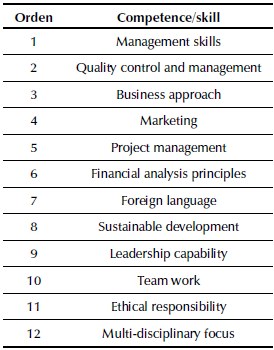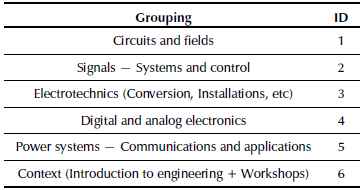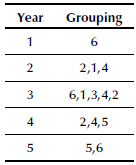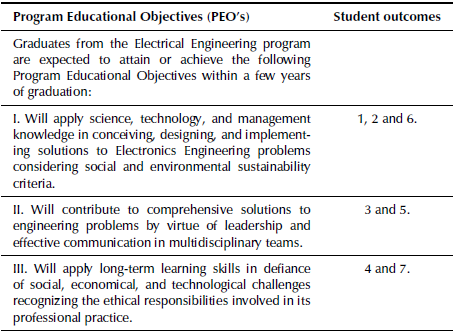Introduction
The year 2021 brings to the School of Engineering of the Universidad Nacional de Colombia - Bogota Campus - the commemoration of its 160 years and, therefore, the authors, on behalf of the Curricular Area of Electrical and Electronics Engineering, join this celebration. It should be noted that only after a century of founding our School, as if the age of majority was reached at 100 years, the emerging specializations in different disciplinary fields gave rise to the conception of new curricula beyond Civil Engineering. Consequently, after its creation, on May 22, 1961, 60 years of the Electrical Engineering degree was celebrated in 2021. Therefore, this occasion constitutes a double dose of celebration for our academic community.
On the other hand, wonderful cabals are woven around the number 60 since Agreement 60 of 1961 of the Academic Council formally originated the Electrical Engineering career. Even beyond his 60 years, our founder, the German engineer Martin Lutz, deployed his best efforts between 65 and 76 years to consolidate this dream (Mejia, 2011).
Additionally, at 60 and 24 years for the Electrical and Electronics Engineering plans, respectively, we can celebrate a relevant academic milestone: the international ABET accreditation, recently obtained in August 2021. Giving some context, ABET - Accreditation Board for Engineering and Technology - is the most prestigious accrediting agency for programs in applied and natural sciences, computer science, engineering, and engineering technology, whose mission is to ensure that an academic program meets the international quality standards of the profession for which its graduates are prepared (ABET, 2021).
This article describes the experiences achieved during the ABET accreditation process that began in 2008 and 12 years later crystallized in this recognition. The experiences will be organized into four large parts as follows:
The CDIO Initiative (Conceive, Design, Implement and Operate); (2008-2012).
The consolidation of the Educational Project of the Program - PEP (2012-2016).
The ABET approach.
Future curricular challenges.
The CDIO initiative (2008-2012)
Generalities
As mentioned, the Electrical Engineering and Electronics Engineering programs have been very active in the curricular revision processes, particularly since 2008 due to the last Academic Reform (CSU, 2007).
Strictly speaking, this reform raised some fundamental principles such as (i) comprehensive training, (ii) flexibility, (iii) contextualization, (iv) internationalization, and (v) interdisciplinarity. Accordingly, the relevant question at the time inquired about which strategies should be used to apply the previous principles to the design of the programs' curricula. As a possible response to such a challenge, the ongoing direction of the curricular area explored some educational approaches for implementing these principles in the study plans. That is how the programs adopted the CDIO initiative (Crawley et al., 2006).
In general terms, CDIO "provides an educational framework for developing the fundamentals of engineering in the context of Conceive, Design, Implement and Operate * real-world systems or products." (Crawley et al., 2006). In particular, this framework is represented by an explicit set of hierarchical skills (4 sublevels) whose development is desirable throughout the curriculum in three different levels of training known as "Introduction (I)", "Exposure (E)" and "Use by the student (U)".
Among other desirable features, this initiative addresses aspects of engineering education that conformed to the new principles proposed in the 2007 Academic Reform where, beyond the purely disciplinary or technical programmatic contents, the development of some fundamental competencies such as oral and written communication and teamwork was demanded by the students (Tadmor, 2006; Kennedy, 2006; Wulf, 1998; Boeing, 1996).
One of the first tasks to advance this initiative consisted in establishing the desirable and necessary competencies for an engineer and the desired level of performance for each one. Today, there is a consensus about the skills engineers must have to compete in a globalized world. Both, graduate engineers and professors from many regions agree that it is necessary to (i) identify the skills and other required competencies, (ii) make explicit the training objectives in all areas, and (iii) establish the appropriate mechanisms to achieve these objectives (Crawley et al., 2006; NAE, 2005; Diamond, 2008; Vest, 2006).
Consequently, one of the fundamental stages of this curricular reform consisted of establishing how to answer the following fundamental questions (Diamond, 2008):
What are the knowledge, skills, and aptitudes (competencies) must graduates of our engineering programs possess? Furthermore, what is the desired level of sufficiency in each of those aspects?
How can we support students to acquire or foster these skills before graduating?
To establish the set of required competencies and the desired level of proficiency, it was necessary to collect the opinion of the programs' main stakeholders (Students, Industry (employers), and Professors) about the pertinence of the acquired competencies during their university education.
CDIO - the point of view of Graduates
The opinion of the graduates of both programs in 2008 (115 and 54 graduates of Electrical and Electronics Engineering, respectively) was estimated through the application of a survey, following a methodology similar to that carried out by the World Chemical Engineering Council (WCEC), whose results are reported in Diaz (2008). This survey asked to rate the importance of some relevant competencies for the practice of the profession, according to the scale shown in Table 1.
Table 1 Scale of levels of importance in each skill or competence. CDIO Graduates Survey.
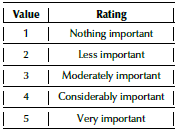
Source: Authors
The results for both programs are presented in Table 2, illustrating the order of importance given by the graduates of each program to each of the competencies investigated.
Table 2 CDIO Graduates survey. Skill's priority reported by graduates about the most required competencies in the workplace.

Source: Authors
Table 3 CDIO Faculty's Survey. Expected proficiency levels in the development of CDIO skills.

Source: Authors
CDIO - Faculty's point of view
The perception of the professors was also estimated through a survey at the same year as the applied to the graduates (2008). The scale of the level of proficiency expected in the students is shown in Table 3. The survey was answered by 28 professors from the program, mostly full-time. The survey results for each level 2 CDIO skill are shown in Table 4.
CDIO - Gap analysis
Once the opinion of Graduates and Professors was collected, the study's primary purpose was to evaluate the most remarkable differences between the competencies required for the job and those that the University emphasizes during the degree. Therefore, for each competency analyzed, the gap was estimated as the difference between the average values of the importance rating given by teachers and graduates. Consequently, the gap will be (i) positive if the University offers tools to achieve more competence than what is required for professional life or (ii) negative if the needs of professional life exceed what is acquired in university education. The results for this gap analysis are shown in Figures 1 and 2 for Electrical and Electronics Engineering, respectively.
The only areas for which the gap was positive were the competencies related to applying physics, mathematics, and chemistry knowledge. On the other hand, for the areas of "Application of engineering concepts" and "Research capacity", the gap is very close to zero, which implies that what is learned during university education is very close to what is necessary.
Table 4 Faculty's CDIO Survey. Resulting scores for the expected proficiency to be developed by the students in any CDIO skill (Level 2).
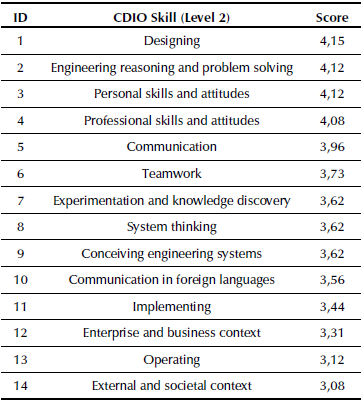
Source: Authors
On the other hand, the skills for which the gap was mostly deficient (negative) are shown in Table 5.
Although Figures 1 and 2 illustrated a situation that could be considered dramatic, it is necessary to mention that this situation was highly consistent with the results obtained in different studies from different countries and with the results from the study of chemical engineers from 63 countries, see DeChema (2004), pages 41-57. In almost all cases, the only skills with a positive gap were those related to purely technical knowledge. Of course, although in 2008 it was a global trend, it was no less problematic.
Similarly, the common characteristic of all these deficient competencies was closely related to the principles of the 2007 Academic Reform, whose spirit went beyond the strictly technical. In this sense, the CDIO initiative was very appropriate to address, in a structured and systematic way, the problem of a curricular design in both programs that could strengthen these competencies.
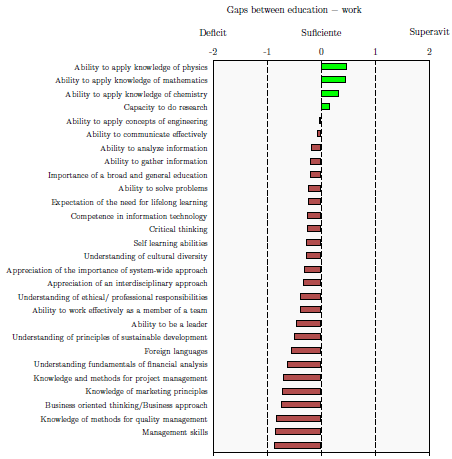
Source: Authors
Figure 1 Electrical Engineering: The gaps between what the University provides and what is required on the job, ordered from largest to smallest. Positive values (green bars) mean excess, while negative values (red bars) imply a deficit between what the University provides and what is required at work.
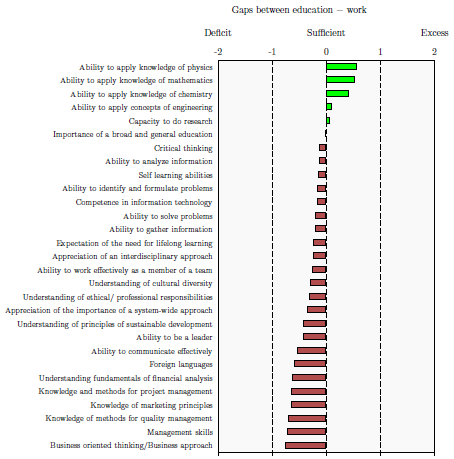
Source: Authors
Figure 2 Electronics Engineering: The gaps between what the University provides and what is required on the job, ordered from largest to smallest. Positive values (green bars) mean excess, while negative values (red bars) imply a deficit between what the University provides and what is required at work.
CDIO - Implementation in the curriculum
As a result of the gap analysis, CDIO skills up to level 3 were selected to be developed along the curriculum. This selection was based on (i) the scores given by the teachers to the level 2 CDIO skills (Table 4) and (ii) the most deficient skills revealed by the graduates (Table 5). On the other hand, the selection of the CDIO skills at level 3 was based on the scores obtained for each skill, so only the skills above the average scores were selected. This selection helped to limit the set of CDIO skills to level 3 so that the levels desired by the teachers matched the most deficient skills expressed by the graduates.
Once the skills up to level 3 were selected, the new challenge consisted of making an adequate distribution of them throughout the study plan. Two variables were considered in this distribution as follows:
Temporality: Determining at what point certain skills should be developed. It was decided to divide the academic trajectory into five periods, each of one year.
Depth: Knowing how deep a particular skill must be developed. In this regard, the previously mentioned levels of Introduction (I - skills developed in a very introductory way and almost at an informative level), Exposure (E - skills formally exposed to the student for future use), and Use (U - the student must use the exposed skills within the activities planned in the subjects).
Similarly, the distribution of these skills was only carried out within the groupings of disciplinary courses in the study plan. This strategy made it possible to define teams per grouping, leading to effective communication among professors of the same work area. The subject groupings for both programs are shown in Table 6.
Now, based on the identification (ID) presented in Table 6 for each grouping, Table 7 shows its location along the years of the academic trajectory (Temporality).
Likewise, skills at level 2 were coded according to the ID number shown in Table 4. Subsequently, the level 2 skills were distributed in each group of subjects, indicating temporality and depth. This distribution was made for each grouping in Table 6. A sample of this distribution is shown in Table 8 for the Analog and Digital Electronics grouping, where I, E, and U correspond to the Introduction, Exposure, and Use levels, respectively. Accordingly, numbers shown in Table 8 refer to the ID number shown in Table 4. For further details on implementing the CDIO strategy, see Gallego (2011).
Table 8 Distribution of level 2 CDIO skills in the Digital + Analog Electronics grouping

Source: Authors
Based on the distribution of CDIO skills at level 2, the professors of each subject received their corresponding matrices (similar to the one shown in Table 8) as input to determine not only what skills but also how deep these skills may be developed. In summary, the implementation in each course was carried out based on the following steps:
1. Reconsider subject contents, strictly in what has to do with the CDIO level 1 skill on technical knowledge and reasoning, that is, the contents related to:
(a) Basic science knowledge.
(b) Basic engineering knowledge and methods.
(c) Knowledge and methods of Electrical Engineering and Electronics Engineering.
2. Document any contents and methodological modifications as a result of the academic reform implementation.
3. Select the skills at level 3 with their respective depth levels (I, E or U).
4. Formulate the learning objectives based on the level 3 skills intended to be developed. For this formulation of objectives, Bloom's Taxonomy (Anderson, Krathwohl, 2001) was used to select a series of verbs closely related to the depth level. Likewise, these objectives were written in such away as to specify what the student should be able to do once the course is finished.
5. Formulate the methodology to follow by describing the activities to be developed during the course along with the objectives and skills that are intended to be developed. It is intended to make a conceptual map between each activity and the skills that are intended to be developed.
The COMFIE Accompaniment Program for students
Parallel to the curricular design process, it was necessary to implement a strategy that would accompany students during their adaptation to university life once they enter the programs. Therefore, an interdisciplinary team was defined between the School of Engineering, the Department of Psychology, and the Student Health division from the Welfare Directorate - (Bogota Campus), which formulated the project called COMFIE - A Study in Promotion of Health from the Academic Practice in Engineering. Phases I - IV. With the support of some professors from the Departments of Electrical Engineering and Electronics Engineering and Chemical and Environmental Engineering and with the leadership of the psychologist Nohora Acuna, this project developed a longitudinal study with four cohorts of admitted students achieving, among others, the following results:
Implementation of disciplinary content articulated methodology, along with the development of teaching strategies to support the student's formative process. For this, the subject Introduction to Engineering was selected as the axis of the implementation with the purpose that accompanying actions were duly articulated to the academic process developed in-classroom. These reflections even gave rise to a greater intensity of work in this subject and therefore, from the logic of the curricular design, it was decided that this course would have the highest number of credits in the student's first semester for both programs.
Beyond the disciplinary learning objectives of the subject, the development of transversal competencies such as (i) teamwork or (ii) oral and written communication, formally became learning outcomes of the course. Since these skills were considered essential, teaching accompaniment around was implemented around specific activities during the course with their corresponding evaluation criteria.
Early self-assessment of the students allowed honing in the skills to be worked on. Entering students were evaluated using two instruments that were designed by the teaching team. They are called "First Semester Student Questionnaire" and "Coping Styles Questionnaire". Thus, the competencies to be developed were selected based on both, the needs indicated by the students and those chosen by the research team.
Once the implementation of COMFIE was completed, the dropout rates of the intervened groups (cohorts 2008-II, 2009-I, and 2009-II) were compared with the control groups (cohorts 2006-II, 2007-I, and 2007-II ), observing a decreasing trend in the dropout rates in the intervened group, which showed that the strategy was successful in its purpose of student accompaniment in a training process beyond disciplinary contents, that is, of comprehensive training. Furthermore, this strategy impacted the culture of the School of Engineering and the Bogota Campus since this strategy was later implemented in the six remaining programs of the School and more than 30 programs at the Bogota Campus. More details on implementing the COMFIE strategy can be found at Acuna et al. (2011).
In conclusion, from 2008 to 2012, the CDIO initiative was the educational approach adopted to address deficient skills regarding our graduates in line with the new challenges imposed by the principles promulgated by the Academic Reform of 2007. Through a structured and systematic framework, this initiative served us to identify the skills students needed to foster throughout the curriculum. In other words, the CDIO initiative helped us to identify the "What?" and "Where?" of the curriculum design strategy while arousing curiosity to start addressing the "How?" of the teaching strategies and the assessment of these skills, steps that would be addressed in later years.
Consolidation of the Educational Project of the Program - PEP (2012-2016)
During 2012-2016, the consolidation of the CDIO initiative and the COMFIE program continued, which impacted the educational objectives of both programs. The declaration of educational objectives in the context of the CDIO initiative is evidenced in the objectives declared in the agreements of the year 2008, where the words "Conceive, Design, Implement, and Operate" were an explicit part of the objectives for both programs (Acuerdo 223, 2008; Acuerdo 248, 2008).
Additionally, in 2012, an institutional initiative was promoted by the National Directorate of Undergraduate Curricular Programs, whose purpose was to formalize the educational projects of all the curricular programs of the Universidad Nacional de Colombia (DIRNALPRE, 2012). In general, the Program Educational Project (PEP) is a document that contains the guidelines, policies, and principles that guide the development of the program. Likewise, it becomes an instrument of reference and navigation within an academic and argumentative exercise of "wanting to be." In this sense, this document must specify the educational objectives of the curricular program and its articulation with the courses included in the study plan so that both the development of these objectives and their evaluation are made evident. (DIRNALPRE, 2012).
Derived from the nature and purposes of this document, it was necessary to carry out a review and formalization of the ongoing initiatives in which the mapping of educational objectives and CDIO skills to the different subjects of the curricular plan was made explicit. These mappings can be consulted in PEP Electrónica (2013) and PEP Electrónica (2013).
Once the Educational Project for both programs was consolidated and, recognizing that the curricular design process followed guidelines that met some international standards, the programs began to analyze whether it was possible to achieve recognition of their curricular dynamics. The recognition exercises at the national level were already carried out, given that High-Quality accreditation had been achieved for both programs before the National Accreditation Council - (CNA). In fact, there was a certain dichotomy in carrying out these recognition processes since the national accreditation models were not adequate to think about a curricular design for educational objectives, and therefore, the reflections on the academic improvement of the programs resulting from these processes were not necessarily so governable and not so academic. Consequently, in 2016, after eight years of implementation of the CDIO initiative, the possibility of achieving an international accreditation that was more in tune with the curricular dynamics of our programs began to be evaluated, and, therefore, the ABET accreditation seemed to be a good alternative.
The ABET approach (2016-2020)
After 8 years of reflections on the CDIO initiative and the consolidation of the Educational Project of the Program, some valuable agreements seemed to have been reached on (i) which skills to develop and (ii) where to develop them throughout the curriculum. However, there were still some challenges in terms of how to assess these skills, which includes some reflections on (i) the development of course activities aimed at developing and measuring these skills, (ii) possible assessment tools, (iii) the frequency of measurement and (iv) a clear feedback and improvement scheme, among others.
At the same time, some professors of the Department had the opportunity to attend some preparatory courses for a possible application to the international ABET accreditation, which was financed by initiatives of the Faculty of Engineering - (Bogotá Campus), the Academic Directorate - (Bogotá Campus), and the National Directorate of Undergraduate Curricular Programs. In contrast to the High-Quality National Accreditation - (CNA), our programs were convinced that the ABET accreditation approach based on educational objectives, provided not only better strategies to be implemented in our teaching-learning activities but also a systematic framework of characterization and feedback to the academic processes that ensured their improvement.
In general terms, the evaluation process within the ABET model can be summarized in two large cycles corresponding to (i) the continuous review of educational objectives and (ii) the implementation and evaluation of learning outcomes throughout the curriculum. Figure 3 illustrates the two workflow cycles mentioned, which will be developed in the following sections.
Table 9 Adopted student outcomes for the ABET accreditation in Electrical and Electronics Engineering.
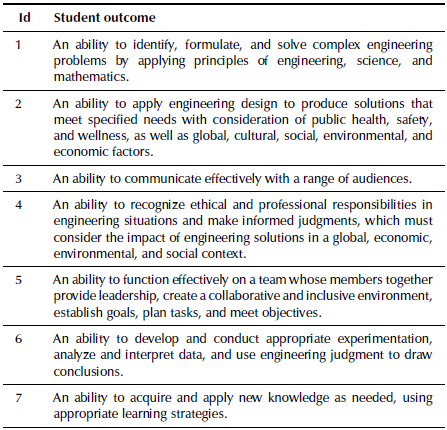
Source: Authors
From the CDIO Syllabus to learning outcomes
One of the first tasks carried out consisted of finding a mapping between the CDIO level 2 skills and the learning outcomes, according to ABET (student outcomes). Regarding the learning goals, it is important to take into account that this equivalence began with a model called A-K (a set of 11 goals or outcomes numbered from literal A. to K.), which became a set of seven learning outcomes in the new ABET accreditation model. In general, this mapping was possible since there was a high degree of correspondence between what the CDIO initiative proposed and the ABET model.
Another important task consisted in determining how the level of achievement of these goals was going to be characterized. To this end, a set of performance indicators was determined through the joint agreement of the teachers of both programs. This step was quite significant since it required recognizing what was considered important in each skill and thereafter, what was teachable in our courses. Consequently, these indicators required the design of specific activities to be carried out in each course. The set of outcomes in the model from 1 to 7 is shown in Table 9.
On the Program Educational Objectives (PEOs)
According to the workflow cycle of the ABET model, programs must have a continuous review of their educational objectives. This review is carried out jointly with the so-called "stakeholders" which, in the case of both programs, were made up of (i) students, (ii) professors, (iii) graduates, (iv) employers, and (v) external advisory committee. In this regard, the external advisory committee represented one of the main innovations in the process, since it required the creation of a collegiate body made up of associations of graduates, employers, and graduates to provide feedback on the objectives and curricular dynamics of the programs.
This new milestone led both programs to review the program's objectives that began in October 2019 through a workshop with graduates and employers where some observations were received on the needs of the external sector that were not explicitly covered in the study plans, among which were notable (i) the development of design skills that include not only technical or economic restrictions but social and environmental ones, (ii) the preparation of transversal skills to function in work environments, and (iii) the importance of ethics in engineering and the ability to resolve conflicts in organizational contexts.
At the same time, a process of reflection was carried out by the faculty on the objectives of the program in light of the learning outcomes that had begun to be formally characterized and evaluated since 2018 in both programs. In this sense, when comparingtheobjectives of the Educational Project of the Program with the ABET approach, there was not necessarily an adequate academic alignment. For this reason, at the beginning of 2020, an adjustment was made to the objectives of the program in such a way that they were better aligned with the learning goals of the ABET model (Acuerdo 181, 2020; Acuerdo 182, 2020). These new educational objectives and their correspondence with the learning goals are illustrated in Table 10, in which it is worth notingthat, for thefirsttime in history, theyare exactly the same for both programs, which constitutes a common agreement on what our students, regardless of the program they are in, should achieve.
Assessment ofstudent outcomes
One of the main challenges in implementing this new approach was the characterization ofperformance indicators for each learning goal. This implied a discussion about the evaluation tools and the proposed methodology for the assessment of each one of the outcomes. In general, the evaluation was developed in two modalities as follows:
An internal evaluation, made up of the characterizations carried out in the courses through the use of rubrics, agreeing on the use of a single rubric that would include all the outcomes and their respective performance indicators. In particular, 4 performance levels were established for each indicator called "Bad", "Fair", "Good" and "Excellent".
An external evaluation comprised the co-advisor's evaluations in student internships or internships and the results of the SABER Protests, which were mapped to each of the proposed performance indicators.
Once the learning goals and corresponding performance indicators were established, a pilot attempt began in 201 7 in 15 courses with 49 indicators. Several instances of the process were reformulated from this initial exercise to make this process sustainable, leading to the assessment during four semesters (years 2018 and 2019) with only 24 indicators.
Other criteria to adopt consisted of the level of "attainment" for which both programs considered that the objectives were achieved. In this sense, it was established that 70% of the students should reach the "Good" or "Excellent" levels for these skills to be considered as "satisfactorily achieved" within the process.
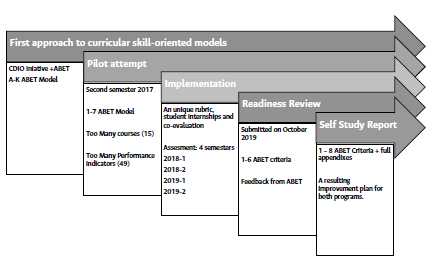
Source: Authors
Figure 4 Timeline for the ABET Accreditation in Electrical and Electronics Engineering.
The details of the subjects, the proposed curricular activities, and the evaluation tools used for each performance indicator can be consulted at ABET Electrónica (2020) and ABET Electrónica (2020).
Likewise, the detail of the rubrics used, as well as the results for each performance indicator and the mapping with the SABER Pro exam, can be consulted at ABET Electrónica (2020) y ABET Electrónica (2020).
Results of the ABET self-assessment
After the characterization was carried out for a period of four semesters, we proceeded to the analysis of each performance indicator and its corresponding assessment. Table 11 shows the main results for each learning goal (outcome). Some of these strengths and challenges will be discussed in the next section. However, beyond the results themselves, it is worth highlighting their particular nature. Unlike other accreditation models, including Colombia's national (CNA) accreditation, the tenor of the challenges earned is completely governable and deeply academic. These characteristics, which can be considered minor, are especially significant in our case. Consequently, the proposals for improvement plans emerging from this evaluation are, for the most part, developed by teachers in the curricular activities during their courses. These features facilitate the mitigation of the detected academic weaknesses since their improvement depends entirely on our intra-classroom academic work at the expense of other initiatives that are not necessarily governable. Details of the proposed action plans can be found in ABET Electrónica (2020) and ABET Electrónica (2020).
Table 11 Improvement opportunities per student outcome detected during the ABET assessment.
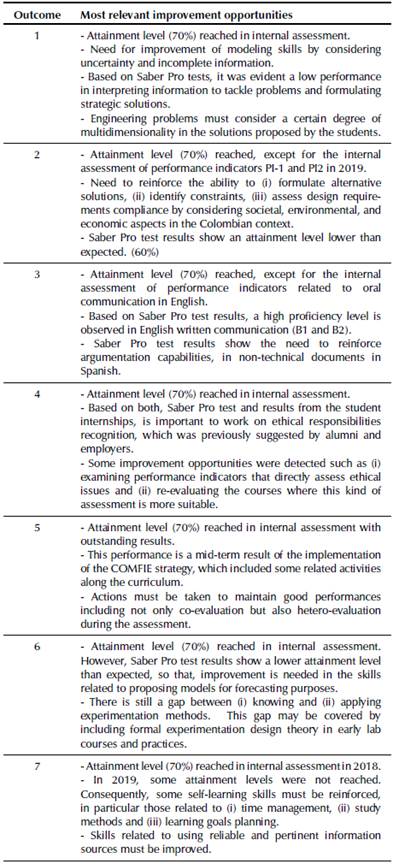
Source: Authors
ABET visit Experiences
A timeline of the processes carried out within the ABET accreditation in Electrical and Electronics Engineering is shown in Figure 4. As can be seen, the application for ABET accreditation begins with a step called Readiness Review, which took place in October 2019 and aims to determine if the programs are accreditable before the ABET accreditation agency.
Once this preliminary evaluation -where both programs were evaluated as accreditable- was passed, the self-assessment report for accreditation purposes was sent in June 2020. Subsequently, the visit took place on November 17-19, 2020, in virtual modality due to the COVID-19 pandemic. For this visit, the ABET agency appointed three peers, one of them as coordinator of the visit (Chairman) and a pair in charge of reviewing each program, all of them with excellent academic track records at top-level American universities and with extensive experience as peer reviewers in ABET accreditations.
Some of the most relevant experiences during this visit are the following:
The visit began a month before the scheduled date. In this accreditation model, the review of the material by the peer reviewers begins one month before the formal date since early contact is established with the coordinating team by the Universidad Nacional de Colombia. During this period, the peer reviewers' concerns abouttheself-assessmentreports sent were cleared up. It is understood that the formal visit constitutes the final part of this process, where interaction with other actors other than the coordinating team is achieved. This process ensured detailed knowledge by the peer reviewers of the self-assessment reports and, therefore, a very objective and rigorous evaluation of the curricular program.
Due to the virtual modality, creating an adequately organized repository with evidence of achieving the learning goals was necessary. This evidence is made up of samples of work carried out by the students and their corresponding evaluation rubrics so that the evaluating peers can verify if the learning goals are being met. This exhaustive review of the evidence constitutes a differentiating element compared to national accreditation.
It was necessary to "virtualize" numerous infrastructure spaces that the curricular programs have. More than 20 videos showed the curricular programs' teaching spaces, laboratories, and other academic spaces (Espacios-Físicos, 2020) have.
Although the model was being implemented and most of the professors were already familiar with the process, the preparation for the visit among the teachers was very rigorous. To this end, numerous preparatory meetings were held to ensure that teachers fully knew the accreditation model as well as the processes of characterization of learning goals and their corresponding evaluation. Several virtual evaluation instruments were even developed to achieve adequate preparation.
Aspects related to industrial safety in laboratories and, in general, in all academic spaces constituted a challenge for the program. Within this accreditation model, security in the facilities is as important as the learning goals, which constitutes a differentiating element concerning national accreditation models. To this end, several implementations were carried out regarding safety guides, signaling, and provision of equipment for the mitigation of occupational risks, fire, and, in particular, electrical risks in laboratory spaces.
The evaluation and feedback times on the program are precise and mandatory. Once the visit is over, specific observations are provided on the weaknesses found in the program. It is noted that the program will have 30 days to demonstrate early improvement actions that reflect the program's commitment to their mitigation. These times are fully met and allow the program to keep real traceability of its continuous improvement process. Once these 30 days have elapsed, the program must have delivered the details of the actions undertaken for improvement. Six months later, the final decision on the accreditation of the curricular programs is received. In our case, at the beginning of August 2021, ABET officially decided that both programs were accredited from 2018 to 2023 in the case of Electronics Engineering and 2025 in the case of Electrical Engineering. In the case of Electronics Engineering, the accreditation was extended until 2025 after requested additional evidence was presented to the agency.
Future curricular challenges
Without a doubt, this international accreditation is the reward for a process that began more than ten years ago in a genuine effort to achieve curricular improvements in both programs. Several improvements have been achieved (See Table 11), and other improvement opportunities have been identified, highlighted in these final paragraphs.
One of the great strengths identified by the peer reviewers was being able to address the aspect of "Complex Problems in Engineering adequately". This aspect is formally defined in the ABET model, whose characteristics mainly involve interdisciplinary approaches to engineering problems. In this sense, the course Interdisciplinary Projects Workshop - TPI, whose implementation originates as a response to the principle of interdisciplinarity proposed during the 2007 Academic Reform, was recognized as the main strength of our curricular programs. This commitment to address real problems in our communities with widely multidisciplinary engineering approaches represents the right path toward comprehensive and socially relevant training.
On the other hand, one of the main challenges is formalizing the development of engineering design skills throughout the curriculum. Although there is a final design experience in both programs, there is still a need to develop additional work on developing design skills, not only in the last semesters but also throughout the curriculum in existing subjects, as is the case of the Engineering Workshops.
Another improvement opportunity consists of incorporating the aspect of multidimensionality in the engineering problems addressed during the curriculum. For example, although the Interdisciplinary Projects Workshop already exists, only some of the problems addressed in this course are directly related to Electrical Engineering and Electronics Engineering. For this reason, it would be convenient to include this multidimensional approach where environmental, social, and cultural contexts are addressed in some of the typical disciplinary problems in the curriculum.
One of the improvement opportunities detected is related to the formal inclusion of uncertainty or missing data in formulating problems within our programmatic contents. In the case of Electrical Engineering, one of the requirements that must be worked on consists of the formalization of Probability and Statistics applications to purely disciplinary problems, which constitutes a unique opportunity to address the elements related to the concept of uncertainty.
Likewise, another of the opportunities for improvement is related to the formalization of concepts related to the theory of Design of Experiments and Data Analysis, which can be part of the thematic offer offered in some courses related to laboratory practices or free experimentation, as is the case of engineering workshops.
Finally, the curricular experiences described in this work are part of the collective effort of a group of professors concerned about curricular design and evaluation. A sample of this genuine interest represents the obtaining of the international ABET accreditation, for which scholarly and rigorous work of more than a decade was necessary for which there was never any obligation in response to an interest of the university government; on the contrary, the primary motivation consisted of an own initiative for the continuous improvement of our academic processes. For this reason, the authors of this article expressly thank all the Department of Electrical and Electronics Engineering faculty for this collective effort in commemorating its 60 years of existence. In the same manner, students, businessmen, graduates, and in general, the entire academic and administrative community that supported the different stages of this path.














